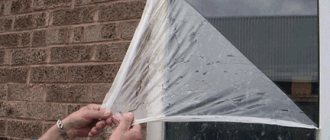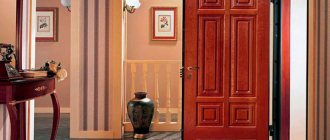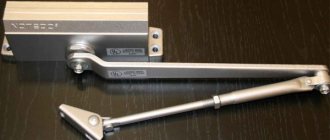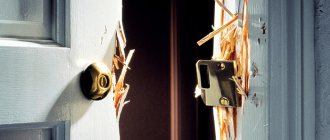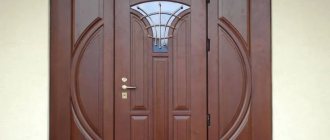Which seal to choose
The choice of sealing tape depends on the thickness of the gap that needs to be eliminated.
If the gap has the same thickness around the entire perimeter of 1-4 mm, you can use a rectangular sealant made of foam rubber, polyethylene foam or polyvinyl chloride (PVC). Rectangular seal
Most often, for metal entrance doors, rubber seals of various shapes are used, the cross-section of which resembles the shape of the letters of the Latin alphabet.
O-profile rubber seal
- The C-profile is used for small gaps up to 3 mm in size.
- K-profile (E-profile) - for the same purposes.
- P-profile and V-profile - eliminates medium-sized gaps of 3-5 mm.
- O-profile and D-profile are installed on doors with a large gap between the leaf and the frame (up to 7 mm).
To prevent the seal from spoiling the aesthetics of the door (see Decorating the front door), it is produced in different colors, which allows you to choose the right one to match the existing door. But the most common and frequently found colors are black, brown and white.
Attention! Experts say that the dye reduces the quality of the sealing rubber. Therefore, if the door is located at the entrance from the street, it is better to sacrifice aesthetics and put a regular black seal on it
Requirements for seals
The tightness of entrance doors is one of the main characteristics that buyers pay attention to. Requirements for it are constantly increasing
The door should prevent heat leakage, protect against moisture seepage (see Why the front door sweats), air, noise, dust and odors entering the house.
In addition, it must lock securely and smoothly. All this directly depends on the quality of the sealing profile used in the production of doors.
Therefore, a modern rubber seal for metal doors must meet high standards of water and air tightness, and also provide good shock absorption of the door leaf during its slamming and abutment to the steel frame. Instead of the loud knocking and rattling noise caused by two metal surfaces touching, you should only hear the soft click of a door lock slamming shut.
The sealant should not harden at low temperatures or peel off from the surface. In all conditions it must retain its sealing and insulating properties.
For metal doors with high thermal conductivity, this is especially important.
Installation of seal
Entrance door with seal installed
On branded metal doors, manufacturers make a special profile into which they install a seal molded specifically for it.
Such a door is considered very reliable in terms of tightness and does not require replacement of the seal for many years
Therefore, it is advisable to pay attention to such details when purchasing or ordering a door.
If you do not have enough funds to purchase a high-quality and reliable product, or if you have already purchased a door without being aware that a rubber profile should already be installed on it, sealing metal doors becomes your concern. This is not difficult to do with self-adhesive tapes; the main thing is to choose a seal of the required thickness and the appropriate profile.
To do this, you can use a simple old-fashioned method: wrap plasticine in a piece of polyethylene, insert it between the frame and the door leaf and close it tightly. Once you open the door again, you will receive a template to determine the thickness of the seal. But keep in mind that it should be in a compressed state.
Installation of the seal is very simple: the protective layer is gradually removed from the sticky side and the surface freed from it is pressed tightly against the door rebate. If you are unlucky and after some time the seal begins to peel off, use Moment glue for installation.
Rubber gaskets
Rubber door seals, thanks to various adaptations, can be adapted to any, including harsh, operating conditions. For their production, acid-resistant, oil-resistant rubber of high technical or food quality is used. Most often, a rubber seal is used for metal doors facing the street. They have a number of positive properties, namely:
The rubber seals on the door are not in danger of cracking, and they are inexpensive.
Types of seals
To install entrance doors that open onto the staircase or onto the street, tubular or strip kennels are used. Tape fittings are a soft cord with a longitudinal section.
Tubular material is a hollow tube that contracts when the canvas is closed. In addition to their shape, insulating elements differ in the types of materials from which they are made:
Rubber
These types of profiles are made from modified polymer types of rubber. They are able to withstand increased operating loads. They do not deform or crack in the heat or when icy. Suitable for filling gaps of 8–13 mm. Rubber elements are not destroyed by oils and acids.
Usually available in the form of a hollow tubular profile in black and white. The rubber sealing tape has a long service life, high insulation against moisture, drafts, and noise. Elements made of porous rubber provide additional thermal insulation.
Silicone sealing elements
Along with rubber, silicone profiles are suitable for installation on metal entrance groups. They are also highly wear-resistant, although after 3–4 years they may become sticky. Suitable for gaps of 7–12 mm.
An additional advantage of the silicone contour is its environmental friendliness. During operation it does not emit harmful substances and is hypoallergenic. Therefore, silicone sealant is recommended for installation in medical and children's institutions.
Polyurethane
Polyurethane materials are characterized by low price and ease of installation. Typically, such a profile is equipped with an adhesive film. But unlike rubber and silicone elements, polyurethane does not have sufficient wear resistance to ensure long-term operation of structures. It is too dense and does not have enough flexibility, so it is rarely installed on metal entrance groups.
We recommend watching the video:
Types of seals, their characteristics
Manufacturers today offer many options for door seals, which differ in material, size and shape.
Each model has its own purpose, so when purchasing a product you need to pay special attention to this
Seal options depending on installation location
Depending on the location of the door block, certain requirements are imposed on the sealing tapes. In order for the selected product to cope with the required task, you must first ask which seal options are intended for entrance door blocks and which for interior doors.
Products for entrance doors
For door structures that are installed in the entrance opening to an apartment or private house, it is recommended to use tube-shaped sealing rubber bands. The sufficient thickness and shape of the product makes it possible to completely seal the technical gaps between the canvas and the box.
To produce such seals, porous rubber is used, which is characterized by high thermal insulation properties and tightness. Most types of tubular products are available with a self-adhesive base, which makes them faster and easier to install on the door structure.
Products for interior doors
The rubber seal, which is specially made for interior doors, does not protect the premises from the penetration of cold air from the street. Therefore, softer materials are used for their production. These can be seals for interior doors made on a silicone basis.
Materials used to produce door sealing strips
Depending on the performance characteristics, seals are made from different raw materials. Also, the duration of the product’s operational period depends on the consumable material.
Silicone, rubber
Rubber is characterized as a wear-resistant material. It is resistant to natural factors (rain, snow, wind loads, sunlight, significant temperature changes).
After the cessation of physical impact, the contour rubber seal intended for interior doors instantly takes on its original shape. These products also prevent the elements of the door structure from sticking together.
Silicone gaskets have similar characteristics to their rubber counterparts. But they are less resistant to wear. Silicone-based products are often used to seal interior door blocks.
Felt, foam rubber
Felt seals are used for wooden structures. This is an environmentally friendly material, which is characterized by high thermal insulation and sound insulation properties. Felt does not rot and fungus does not form on it.
Self-adhesive sealing tape made of foam rubber for doors is the most affordable. But they do not have such good thermal and sound insulation characteristics as felt seals. Main disadvantage: short service life. After 2-3 months, the foam rubber needs to be changed as it decreases in size and begins to let air and outside noise through.
Magnetic
Magnetic products consist of several magnetic strips, lined with soft material, which protect the hard surface of the magnets from damage during operation. At the same time, the soft coating significantly reduces the sound when the door slams when it closes.
Magnetic elements are not afraid of temperature changes and exposure to the natural environment. They retain their shape for a long period of time and have fire-fighting characteristics. But if struck strongly by a hard or sharp object, the magnetic tape may break.
Brush
Brush sealing elements are used for sliding door leaves. They are designed to prevent debris and dust from entering the premises from the other side of the door.
Primary requirements
When choosing a seal for the front door, you need to start from the size of the gap that needs to be closed. For example, if the size of the gap when the door is in the closed position is 1-4 mm, then you can install a rectangular rubber band from:
Only rubber products can be a good seal for a metal entrance door. Today on the construction market there are such materials of various colors, which means you always have the opportunity to choose specifically for your door. The most common are black, white and brown. There is an opinion that when adding dye, the quality of the rubber decreases somewhat, and therefore it is worth purchasing a black seal that does not sparkle with originality.
Such materials must meet their basic requirements. First of all, this concerns ensuring complete tightness and protecting the room from penetration:
The door will close smoothly without leaving any gaps. After installing a seal for a metal entrance door, if the product is of good quality, it will not make sharp sounds. It must withstand temperature changes; such stability will not allow it to peel off or harden. The sealant, regardless of operating conditions, should never lose its main properties. It is also important that such products will help protect the door from damage that occurs due to drafts, which often lead to their sudden slamming.
As you can see, it is this seemingly insignificant detail that can ensure smooth closing of the door, tightness, improve sound insulation and retain heat in the room.
Source
Which material is better
You need to select insulation for the front door based on your goals: to ensure tightness, temporary insulation, long-term use.
For example, if you plan to replace wooden structures with metal-plastic ones, then you can use inexpensive foam rubber insulation, the service life of which is 1 year. Further, under the influence of temperature changes and dust, the foam rubber loses its properties and crumbles. Such insulation will be inexpensive, but will not last long, especially in outdoor conditions.
For heavy metal doors, it is necessary to glue durable rubber. Its shelf life is up to 15 years. A correctly installed product does not stretch, shrink or peel off during use. The rubber that is used for entrance iron structures is usually porous, which makes it possible to retain heat in the room. You can determine the end of the product’s service life by the appearance of the rubber layer: it will begin to peel off in some places.
For internal structures, silicone or rubber linings are the best. They have the same properties and last a long time. For small gaps, you can buy thin rubber or silicone. At the beginning of the process, you need to measure the width of the gap and select a specific brand of product in the store.
A budget option for self-adhesives is foam rubber. Their service life is up to 2 years in an apartment.
To seal the wardrobe, fleecy tape is used.
It is needed to prevent dust and odors from getting on clothes.
This solution is especially relevant when the apartment layout is made according to the studio principle: there are no interior walls, the kitchen and closet are located in the same room.
Pile tape is a thin sealant that has an adhesive surface on one side and long-pile fabric on the other. This self-adhesive does not reduce noise (and this is not necessary), but it prevents the penetration of dust due to the tight fit of the sashes.
Classification of door seals
There are types of seals that differ in size, material and purpose.
— The sizes can be thin, thick, wide, and so on;
— Based on the material:
- Rubber seals are most often used for entrance, driveway, and street doors due to the ability of modern types of rubber to adapt to any external conditions;
- Silicone seal cannot boast of such characteristics as durability, so silicone is only suitable for interior doors, but here it has no equal.
- Seals made from new silicone and rubber mixtures have excellent frost resistance, elasticity, brittleness, aging resistance and durability.
- A foam rubber seal can be a worthy competitor to the above, except for its price; in other respects, foam rubber is far behind. Often such a seal is not enough even for a season - it shrinks, loses its properties, and then, under the influence of external factors, literally turns into dust.
- You can also recall such a material as brush (fluffy) tape; it is not created to provide sound insulation and thermal insulation, but it traps dust well, so it is installed on doors in wardrobes.
- The magnetic seal presses the leaf against the door frame as much as possible; as a result, the magnetic seal provides greater sealing than, for example, silicone or any other.
- A special story is fireproof seals that can localize a fire and stop its spread. The active materials are swelling graphite and a binder with a strong structure. Thus, fireproof seals are based on foaming materials that close the space between the frame and the door, preventing the flow of oxygen into the room. First of all, fire seals are designed for wooden doors that cannot withstand high temperatures. As a result, people and property from wooden buildings have time to evacuate. Fire seals come in the form of strips of special panels with a plastic or polyethylene sheath.
— By purpose, that is, by the type of door for which they are suitable:
- A thick seal with a hollow tubular base is installed on the front door. The thick material and internal cavity guarantee an excellent fit between the door and the frame. The seal is rubber, but such products use special, porous rubber, which enhances thermal insulation several dozen times. This seal is always self-adhesive, which is good, even taking into account the fact that such tape sooner or later comes off, you can install a new one without any problems.
- The seal for interior doors is made of soft rubber, sometimes silicone, it does not always have good thermal insulation and fireproof properties, although this is what allows the material to have a good, delicate structure.
- Seals for plastic doors are not suitable for others. Moreover, they do not replace each other, since door manufacturers make a special configuration of grooves and seals for them. Otherwise, such products are worthy of all praise - they are easy to replace; the tape is positioned in such a way that the influence of the environment is minimized, therefore it performs its functions in any weather.
- The seal for glass doors is usually silicone, but with a special profile section. It must be glued to the end of the door using water, and after drying it holds tightly. True, this does not apply to glass doors with an aluminum profile, the seal for which is made in the same way as for plastic doors.
- The seal for metal doors can be either foam rubber or rubber, silicone; fireproof or other seals are suitable. Some of them are equipped with a metal pressure strip, but it is better to buy a self-adhesive one. A roll seal for metal doors can contain about 6 meters of material, that is, one roll is enough for a standard door.
- Depending on the thickness of the gap that needs to be closed, sealants are used for metal doors of different sections. They also come in different colors, but it is better to choose black, as the dye can reduce the quality of the rubber.
- For wooden doors, floor slats are used: wedge-shaped strip, tubular made of plastic and others. The mortise seal is also suitable for wooden doors. It is inserted correctly by cutting into the base of the box.
Mounting types
There are sealing elements with self-adhesive tape, with magnetic fastening, and also with an additional clamping mechanism.
Magnetic seals
This new product appeared on our construction markets relatively recently, but has already become quite popular.
A magnetic seal for metal doors is a special frame that exactly follows the contours of the door opening. The product consists of a special magnetic insert, as well as a soft sealing part. The material used is thermoplastic elastomer. It has several advantages - after the product is worn out, it can be sent for recycling. In addition, thermoplastic elastomer is highly resistant to adverse factors and temperature changes.
tax deduction for apartments for non-working pensioners 2020
Magnetic seals are also resistant to ultraviolet radiation and moisture, reliably protecting the room from extraneous noise and drafts, dust and dirt. With these elements, the door will close quietly, and powerful magnets will attract the metal leaf to the door frame, thereby ensuring high tightness and silent closing.
For metal doors, triple seals should be used. The first two are located on the canvas, and the third is on the door frame.
Advantages and disadvantages
The thermoplastic elastomer door seal has the following characteristics compared to other similar products:
Magnetic seals have the following disadvantages:
Principle of operation
The operating principle of a metal door seal is that during the closing process, the doors are attracted to each other by built-in magnets with opposite poles. This connection ensures a complete fit of the frame to the canvas, which guarantees the tightness of the structure better than self-adhesive rubber material.
Magnetic elements are installed on an iron or steel type of canvas.
Installation of magnetic seals
This process will not take much time and will not require any special skills. Of course, it is better if professionals do this. Such systems are installed on canvases where there are no decorative elements.
Although this seal for metal doors has many advantages, it is not suitable for everyone. The main thing is to choose the right strength of the permanent magnet so that children do not have any difficulties.
How to choose a seal for a metal door?
The first step is to decide on the size of the tape, its type and shape. Most often, this fittings are sold in rolls of 6 meters, which is quite enough for a standard entrance door. But for good insulation, several layers of sealant are used, this must be taken into account immediately when purchasing.
Tips for choosing a seal:
In addition to these characteristics, the color of the material is also important; it is selected depending on the design of the door. But the most successful product is considered to be black: no dyes are added to it, and they usually reduce the quality of the product. It is the black seals that are installed on the outer door, where the insulation requirements are maximum.
What to look for when purchasing?
When choosing a seal for steel doors, you need to carefully inspect it and check its quality.
In particular, you should perform the following actions:
Most often you can find such products on sale from Germany, Sweden, Poland or Turkey. A good product should not harden when the temperature drops, or peel off when it fluctuates; release toxic compounds into the air.
Installing and replacing seals on various types of doors
The tools needed for self-installation are simple and can be found in every home:
- pencil or marker;
- tape measure and ruler;
- sharp knife;
- brush with long (2–3 cm) bristles.
To install the brush seals, you will additionally need a hacksaw.
The glue used is waterproof, preferably rubber. Acetone solvents and sandpaper are used to degrease and clean the edge of the door.
When working with solvents, it is necessary to protect the respiratory system from toxic fumes with a respirator.
If the old seal is being replaced, it is necessary to remove the used tape from the doors and carefully treat the surface with fine sandpaper. Before directly gluing the tape, the end of the frame (or canvas) is washed and degreased. Small tubercles are ground off, and small depressions are puttied (pre-filled with glue and dried).
Depending on the type of gasket, there are certain installation nuances. After familiarizing yourself with them, everyone will be able to install thermal insulating tape on their door themselves.
Sealing metal doors
Since a metal door has a smooth surface, self-adhesive or simply adhesive seals are most often used. The sequence of actions is as follows:
- Preparatory work. Remove the old sealant (if any), clean and degrease the surface.
- Marking and cutting rubber tape. It is advisable to draw a line for installing the gasket in advance.
- Pasting the gasket:
- If the seal is equipped with an adhesive layer, the protective film is removed. If not, the surface of the door is coated with glue;
- fixation begins from top to bottom, step by step. The film is removed 20–25 cm at a time and the seal is glued to the door;
- At the corners the tape is cut at 45° and joined closely with a minimum gap.
The main mistake when working with silicone and rubber products is over-tensioning the tape. You cannot tighten the gasket during installation; it must be laid in a loose, “relaxed” state.
Video: how to properly glue a seal to an iron entrance door
Installation of seals in wooden doors
The seal is mounted on a wooden base in two ways - with glue (we discussed it above) and in a groove. The second method is considered more reliable. The procedure for installing the seal in this case is as follows:
- The back side of the sealing tape is located. It is a perpendicular “process” with a comb surface.
- A piece of the required length is prepared and pressed into the groove with a brush. In this case, you need to ensure that the tape lies evenly and without distortions in the recess.
- The joints are cut at an angle of 45° and, if necessary, glued with waterproof glue.
Installing a seal in a plastic door
Plastic doors are equipped with seals at the manufacturing stage. In everyday life, it is often important to replace a used part. The door design includes a special molding (groove) for installing the seal on the adhesive. Therefore, to replace you need:
- Remove old rubber band. In practice, it is simply torn off by forcefully pulling the free end.
- Clean the recess from glue and rubber residues.
- Apply a fresh layer of adhesive with a brush and carefully (without stretching) stick on the new seal.
- Join the corners at 45°. To do this, the ends are cut with a sharp knife and additionally coated with glue on the inside.
- Close the door and wait until the glue sets (from 30 minutes to an hour and a half).
Installation of brush seals in sliding doors
Sliding doors are most often equipped with brush seals. Sometimes they are also called antithresholds. Due to design features, the installation of brushes differs from the installation of rubber and silicone gaskets. They are mounted at the bottom of the door or (less often) at the side end.
The installation diagram is very simple. If the door has a flat and smooth surface, the brushes are glued to double-sided tape. If there are doubts about the strength of the adhesive layer, the fixation can be further strengthened with screws. The work steps for installing a brush seal are as follows:
- Preparing the end of the door leaf - cleaning and degreasing before sticking.
- Cutting the workpiece - the seal is cut to the width of the door leaf.
- Fixing brushes on the door.
Some models of brushes are attached using brush holders - special metal or plastic profiles. Most often they are used on doors with large dimensions - in garages, warehouses, etc. In this case, a mounting profile is first installed, and then the brushes themselves are attached to it.
Gluing rules
How to glue a seal to a door. Installing self-adhesive elements is not difficult, but there are several nuances that need to be learned before starting work so as not to damage the product.
The seal for wooden doors should be installed as follows:
- The first step is to remove the old stickers from the tree, if there were any there.
- Measure the width of the gaps and select the size of the insulation, as well as the total length of the perimeter with a margin of 50 cm.
- Clean with sandpaper to ensure that old dust and debris do not interfere with installation.
- The area must be wiped with a cloth soaked in alcohol, acetone or gasoline.
- Measure the length of the sides with a tape measure and measure on the prepared material.
- Remove the protective strip from the seal and stick it first on the top side, then on the bottom, then on the sides.
To make the joints at the corners look neat, cut the strips at an angle of 45 degrees. The product will completely stick in 2 – 3 hours. After this, the door can be opened and closed.
The self-adhesive seal for metal doors is mounted in a similar way. The doorway is cleaned with sandpaper and wiped with white spirit or gasoline.
Next, the protective tape is removed and the box is sealed. To completely seal the entrance, you need to glue the door itself at the junction.
In this case, the sealing material should be selected taking into account the double lining, otherwise the entrance structure will be difficult to close.
Thin self-adhesive overlays are suitable for plastic windows. Before installation, wash the plastic and dry it. Next, moisten the cloth in a degreasing composition and wipe the windows in the place where the self-adhesive is to be installed.
The surface of the plastic is smooth, so this procedure will be easier. You will need to remove the protective tape and glue the cover. Then carefully trim the corners.
With the help of various modifications of seals, you can inexpensively solve several problems at once - reduce noise levels, save on coolants, eliminate furniture defects. Depending on the budget, it is possible to insulate the room for a period of 1 to 15 years.
How to change the seal
Replacement is performed in the following order:
- The old gasket is carefully removed, and the seat is cleaned of dirt and residual adhesive solution.
- The sash is removed. To do this, pull out the pin. You can pry it off with a chisel or a thin flat-head screwdriver.
- Regardless of whether the sealing rubber is attached with glue or simply inserted into the groove, the corners are coated with an adhesive solution.
- The gasket is mounted with a continuous tape: the fewer joints, the better. The cord is laid without tension; it should fit freely in the groove.
- The excess part is trimmed with a painting knife. A joint is made in the corner and secured with glue.
- After the glue has dried, the sash is inserted into place, and a pin is inserted into the hinge.
Signs of correct installation:
- Ease of operation of the sash when opening or closing.
- No blowing.
- The sealing cord remains in the groove after several cycles of operation of the sash.
The new gasket is coated with silicone-based lubricant.
The process is shown in detail and clearly in the video.
Additional details
Door seals determine the quality of sound insulation of a car interior. You can seal the cracks with your own hands, which will improve ride comfort. The driver installs additional kits at his own discretion. The cost of parts and labor for their installation is low.
The simplest option for additional compaction is using Flex. A special tube can be purchased at an auto or air conditioning supply store. How to glue rubber seal to a car door? On glue or tape (double-sided). The fixation is reliable, but you will first need to degrease the surface.
One tube runs from the top, following from the bottom of the windshield and reaching the back door. The flex should go over the back door, then along the contour in a downward direction. Simply fixing it with glue is not the best option; the additional elastic band will quickly come off.
The first door closures are usually tight, but after a day Flex takes the required shape.
The effect after additional compaction is noticeable immediately. The cabin becomes comfortable, the amount of noise decreases, the wind stops blowing in the car, there is no dust and its characteristic aroma. The material is cheap, self-installation takes 30-60 minutes. If you cannot repair the car yourself, contact a service center.
Tips and tricks
To reduce the need to replace seals and extend their service life, you need to follow the simplest recommendations. To maximize the insulation parameters, you can use glazing beads that seal the middle of the profile. The narthex is sealed with an elastic cord attached to the sash along its entire length. To ensure that seals work as well as possible and last longer, window units should be washed regularly. The material itself is rubbed with a slightly wet cloth.
It is recommended to avoid fogging and freezing. Caring for the condition of the surface of a gray or black substance means covering it from fat, acids and other harmful substances. The fittings do not require special maintenance, but they definitely need to be lubricated. It is also advisable to regulate the pressing force of the sash, weakening it in the summer and strengthening it when cold weather approaches. It is also useful to treat the sealant with regulated substances.
Washing seals involves using a damp cloth. In addition to plain water, you can use LOC solution. How often to wash the gasket depends on its material. Silicone is washed relatively rarely (once every 3 months), while other materials will have to be processed more often. Sometimes they use the Edelweiss kit, which by default includes everything you need for a full-fledged service.
Use for lubrication is prohibited:
- glycerin mixtures;
- butter, machine and vegetable oils;
- Vaseline (all these substances can have a detrimental effect).
Cleaning of dirt and dust under the petals should be carried out only with soft tools. Knives, screwdrivers, chisels, chisels, and so on, along with removing harmful inclusions, can damage the material itself. And damage, including even microscopic ones, poses a serious danger and negatively affects service life. Moreover, the seal needs to be cleaned maximum once every 12-24 months. An exception is windows installed in particularly dirty places; If you lack experience or confidence, it is better to hire a team of specialists.
When purchasing a lubricant, especially outside specialized hardware stores, you need to pay attention to compatibility with the material being processed. By observing this condition, you can buy the product even in a car store.
Important: after removing the seal, wash it in warm water with soap. Regardless of the durability of the initially applied drug, the protective layer must be renewed
If fragility is detected, if the seal crumbles, it will not be possible to restore its properties; you can only replace the material.
To learn how to change the seal on windows, watch the video below.
How to glue rubber to metal: instructions for use
First you need to clean the gluing areas from dirt and clean the painted base. The second stage of preparation is degreasing, which increases adhesion. Then you will need to do the following:
- lubricate both parts with a thin layer of adhesive mass (approximately 2 mm);
- Place the parts tightly together and hold until the glue hardens (you can use a vice or a press);
- Sand off the protruding frozen mass with sandpaper or cut it off.
It is advisable to start using the glued item no earlier than one day after the repair.
Installation of seals
This procedure is quite simple, but it is still necessary to do all the work according to certain rules. So, all actions will be divided into a number of stages.
At the first stage, the surface will be prepared. First, you must completely remove the old sealing elements (if any), and thoroughly clean and degrease the gluing areas.
It is very important to completely remove all dirt and dust
Then a new self-adhesive insulation is applied
It is important to choose the right profile and material so that it fully matches the characteristics and dimensions of your doors or windows. You should also pay close attention to the color - it should be in harmony with the product where it will be installed
The seals are first glued to the top of the windows or doors. Then - to the bottom, and then to the side parts. After just two hours, you can fully use the door or window for its intended purpose. The adhesive composition on the sealing profile is of very high quality - it adheres firmly to the surface and will not come off during use.
When purchasing, it is most profitable to purchase material for all windows and doors at once - the sealant is supplied in large 40 m rolls. All the advantages of such products can be assessed as soon as possible after installation. In winter, the effectiveness of these elements will also be clearly visible.
If the seal will be installed on the front door, then some installation features should also be mentioned. In order to obtain the maximum level of sealing of the door entrance structure, the sealing elements must be glued not only to the surface of the door frame, but also to the door.
Along the perimeter it is necessary to glue the place where the canvas will adhere to the outside of the box. The area where the fabric adheres to the inner quarter is also glued. In this case, the seal is glued not to the surface of the door, but directly to the frame. This is real double protection that can reliably protect your home from drafts, winter cold, and extraneous sounds.
So, a self-adhesive seal is an effective solution to the issue of heat and sound insulation. The product is easy to install and has a fairly long service life. When choosing, the main thing is to choose the right type of product. This will help ensure a decent level of adhesion to surfaces.
With the help of these recommendations, each person will be able to find a suitable insulating element for themselves and install it on a door or window themselves.
Functions
The most important function of the seal is protection from drafts. If a device cannot cope with this task, it is a priori of insufficient quality. This is especially true for entrance doors: thermal insulation in this case is extremely important, and only a sufficient level of insulation can ensure it. An important thermal insulation function “works” in both directions, simultaneously protecting the apartment from cold wind from the street or from the entrance and preventing heat from escaping from the home. It is estimated that doors that are not equipped with a seal release up to 40% of all the heat generated by heating appliances. Heating prices are currently quite high, so no one wants to waste precious heat.
Speaking about thermal insulation, one cannot fail to mention that a number of products can withstand significant temperature fluctuations. The amplitude can vary from -65 to +95 degrees Celsius. Thus, by installing high-quality insulation on the front door, you don’t have to worry about it cracking in summer or winter.
Another advantage of the seal is its noise-insulating properties. They are inherent in both metal water doors and interior doors. It happens that the front door is right next to a road or a playground, and the insufficient level of sound insulation does not allow residents to feel comfortable enough, because annoying sounds from the street are very disturbing. If the rooms are not well isolated from each other, then another problem arises: the impossibility of everyone doing their own thing without the risk of disturbing the other. Good sound insulation makes situations comfortable when, for example, they play the piano in one room and read in another.
Shock absorption properties are another important factor. Everyone has encountered a situation where in the summer, due to open windows, drafts flow through the house, and the doors close with a strong bang, disturbing not only the residents of the house, but also their neighbors. The sealing tape conceals unpleasant sound, preventing the creation of annoying slams, and also extending the life of the door and door frame (due to sharp slamming, they wear out faster).
The seal protects the house well from unnecessary odors or smoke. For example, something may burn in the kitchen. No one wants the “aroma” of burning to instantly spread throughout all the rooms, so insulation will help keep the smell out only in the kitchen. The same can be said about the door to the bathroom: it is better to leave wet steam directly within the bathroom and not let it out into the hallway or corridor.
Thus, the main property that a door seal has is sealing the door leaf
In the Russian climate, this property of the door is extremely important due to strong temperature changes on the streets. Moreover, you should carefully consider the choice of product if you live in a large noisy city, because many cities are very busy both day and night
It is for such “sleepless” cities that doors with seals for enhanced sound insulation are well suited. When choosing a door to the kitchen, you also need to make it as airtight as possible, because it is not always appropriate and pleasant when food smells are heard, for example, in the bedroom.
Seals are classified according to several criteria. The first of these is the type of door:
For entrance doors. The door seal for entrance doors is usually made tubular. The profile with a cavity inside completely ensures a sufficient fit of the door, contributing to complete isolation from external influences.
For interior doors. Here completely different requirements are presented: there is no need to protect the room so strongly from the environment; the aesthetic component comes first. In some cases, isolation is important (for example, in the bedroom), but not required.
For plastic doors. Seals for plastic doors are placed in a separate category, since they differ significantly from seals for ordinary doors. It is necessary that the groove element reacts well with the environment. As a rule, such seals are installed on balcony doors.
Please note that, as a rule, only a part that is produced by the same manufacturer as the door itself is suitable for a plastic door.
For glass doors. The profile, which is attached directly to the glass, can be aluminum or silicone
Silicone elements must have a special cross-section; they also serve as insulation, while an aluminum profile must have a special rubber seal. A silicone glass seal is suitable for rooms with high humidity, since there is no risk that it will “come off”.
Checking the reliability of the installed seal
Immediately after you have installed the new gasket, you need to check whether everything was done correctly. To do this, you need to check the following points:
- Is it easy to close and open the sash;
- whether the drafts have disappeared;
- Does the seal remain in the grooves when opening and closing the window?
When installing the seal, it is important not to leave any gaps. If the answer to all these questions is yes, then you should immediately treat the gasket with silicone lubricant applied to the fabric
It increases the service life of the product and improves its performance characteristics
If the answer to all these questions is yes, then you should immediately treat the gasket with silicone lubricant applied to the fabric. It increases the service life of the product and improves its performance characteristics.
On a note! It is not recommended to use lubricant to treat the seal in the cold season. It is best to do this twice a year - in autumn and spring.
If you don’t have the time, effort, skills, tools or simple desire to install the gasket yourself, then you can do this by using the services of experienced specialists who will replace the seal on a plastic window. The price of this work is low - about 1000 rubles, it depends on the type and size of the window, the complexity of the work and a number of other factors.
The tighter the seal fits to the frame, the longer it will last.
Installing a seal on a metal door
Modern metal doors are often equipped at the factory with a special profile with a rubber seal. However, a high-quality entrance door is a rather expensive product, and therefore many people purchase cheaper designs or make them themselves, and therefore the issue of sealing the gap between the door leaf and the frame often becomes a concern for the homeowner.
If you use self-adhesive tape, the whole process will not take more than 10 minutes. The main thing in this matter is to choose the right profile thickness. There is a simple trick for this - a piece of plasticine wrapped in fabric is inserted between the frame and the door leaf at the largest gap, after which the door closes. Once the door is opened, the homeowner will have a ready-made thickness template from which to select the appropriate seal.
In turn, direct fastening of the tape comes down to simple manipulations: the protective film is removed from the side on which the adhesive is applied, after which the tape is pressed against the door rebate. Thus, the entire door structure around the perimeter is pasted over, and the remaining tape is cut off with a knife.
Selection and classification
The material is selected taking into account the width of the vestibule
They also take into account the distance between the door leaf and the frame
This is important because
Seals are available in different options, differing in size. When choosing a self-adhesive material, it is recommended to take into account the expiration date. The fact is that over time, the adhesive substance applied to one side of the product loses its properties. Because of this, the sealing tape adheres worse
because seals are available in different versions, differing in size. When choosing a self-adhesive material, it is recommended to take into account the expiration date. The fact is that over time, the adhesive substance applied to one side of the product loses its properties. Because of this, the sealing tape adheres worse.
The degree of elasticity of the product should also be taken into account. This parameter is checked as follows: you need to squeeze the sealing tape with two fingers; when released, the shape is restored. The material should be of medium hardness. A soft seal will not provide a sufficient seal. As a result, the material will not perform its functions: leaks in the structure will remain. A soft tape will only be effective if the error in the design of the door leaf and frame is minimal.
A stiffer tape is also used for the entrance metal door. It is subject to less wear and tear. It is believed that this option does its job better. However, the hard seal is thick and therefore not suitable for all doors. In addition, during operation, the material loses its properties faster, since it is regularly subjected to heavy loads due to the fact that the door leaf and the ledge have to be pressed harder against the frame.
What are the types
To seal the ledge of a metal sash, several types of products are used, differing in the type of material:
- rubber;
- polyethylene foam;
- foam rubber or polyurethane foam;
- plastic;
- silicone
The rubber seal lasts a long time, is less susceptible to external factors: it does not allow air to pass through, is non-hygroscopic, and is not prone to cracking. This is a flexible material that is offered at an affordable price. With its help, it will be possible to eliminate drafts, but care should be taken to increase ventilation in the room by forced means, since the use of airtight materials helps to weaken air circulation.
Silicone seals do not contain harmful substances and are elastic. They are often used in steel structures, for example, in entrance doors in facilities such as hospitals, schools, kindergartens. The products represent a group of hypoallergenic materials, for this reason they are recommended for installation in rooms where there are children.
If we consider a polyethylene foam or polyvinyl chloride foam seal, this option is flexible and soft. However, it does not last long due to the high degree of abrasion. It is better to use products of this type to seal interior doors, or you will have to change the sealing tape on the metal entrance door ledge more often. Plastic products are in less demand.
There are three types of seals, differing in the method of fastening:
- Self-adhesive - an adhesive substance is applied to one side of the product.
- With clamping system.
- A magnetic seal for metal doors is more suitable. It consists of several circuits, one of which must be attached to the frame, the rest - to the sash. If the magnetic properties of the tape are strong, the door will be difficult to open.
Classification by seal configuration:
- if the leaks do not exceed 3 mm, use a C-, E-, K-shaped profile;
- for structures with gaps from 3 to 5 mm, a V-shaped version of the product is suitable;
- For doors with leaks from 5 mm, O- and D-shaped profiles are used.
If the gaps are small (1-3 mm), use rectangular material.


